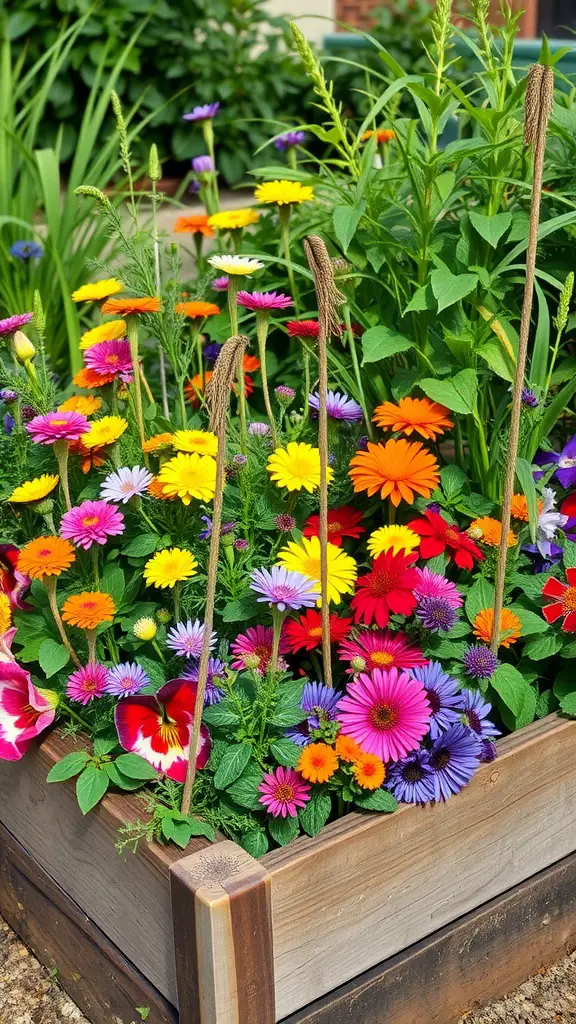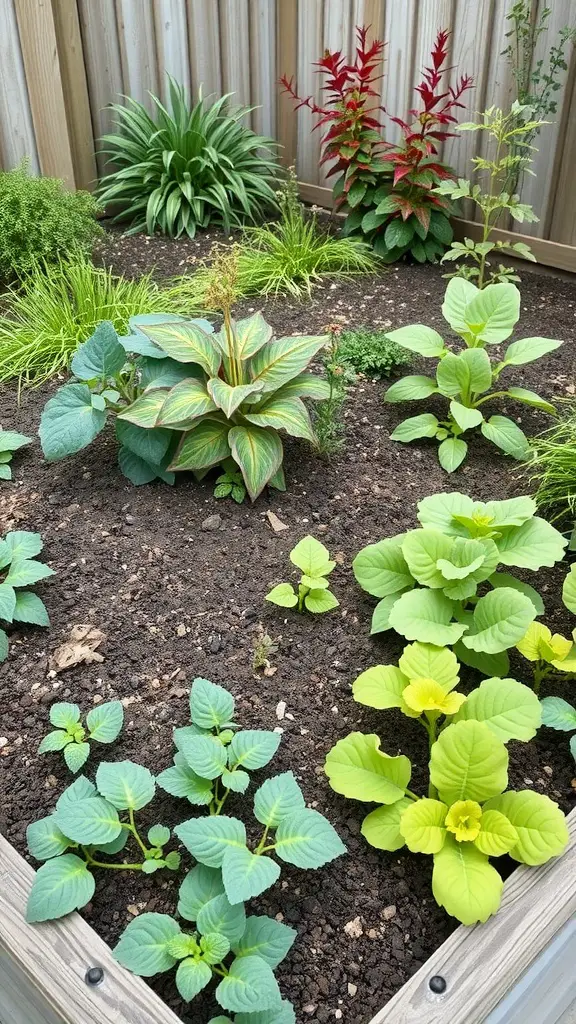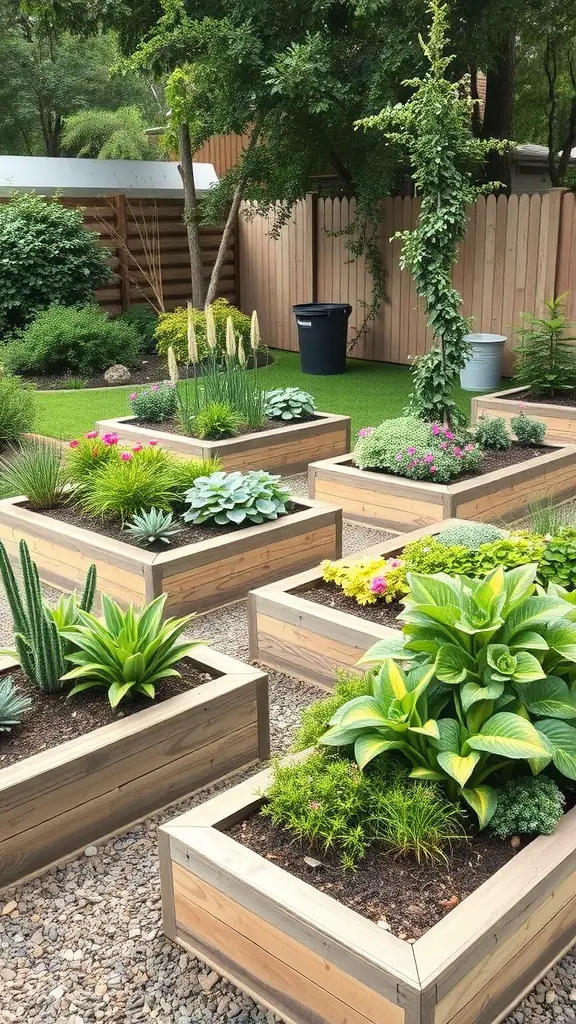Diving into the world of gardening can be both exciting and rewarding, especially when you design your own raised garden beds. Whether you have a spacious backyard or a cozy balcony, we’ve put together 19 creative layout ideas that cater to various styles and spaces. From simple designs to more intricate arrangements, these ideas will help you maximize your garden’s potential and give you a productive outdoor space to enjoy.
Tiered Raised Garden Beds for Small Spaces

Tiered raised garden beds are a smart solution for anyone with limited outdoor space. This layout allows you to make the most of vertical space, creating a visually appealing garden while maximizing planting area.
In the image, you can see a charming set of tiered garden beds made from wood. Each level is filled with rich soil and a variety of plants. The plants range from herbs to leafy greens, showcasing how diverse your garden can be in a small footprint.
The tiered design not only provides ample planting area but also makes it easier to care for your plants. With a little creativity, you can easily incorporate different heights and textures, adding depth to your garden. Plus, having your plants at different levels means you can access them without having to bend over too much.
For those with small yards or patios, this design can be a real lifesaver. It’s a fun way to grow your own food while making the most of your available space.
L-Shaped Raised Garden Bed Designs

L-shaped raised garden beds are a creative way to maximize space while adding visual interest to your yard. This design allows you to create corners that can be filled with a variety of plants, making it both functional and attractive.
In the image, you can see a beautifully arranged L-shaped garden bed filled with colorful flowers and lush greenery. The vibrant blooms add a pop of color, attracting pollinators like bees and butterflies to your garden. The structure itself is made with wood, providing a rustic charm that complements the natural surroundings.
One of the advantages of L-shaped beds is that they can fit snugly into corners of your yard, making use of space that might otherwise go unused. They also allow for easy access to all sides, making planting and maintenance a breeze. Plus, you can mix and match different plants in each section for a diverse garden.
If you’re considering adding an L-shaped raised garden bed to your garden, think about what plants you want to grow. Combining herbs, vegetables, and flowers can create a vibrant and functional space. Be sure to consider sunlight and watering needs to keep your garden thriving!
Integrating Raised Beds with a Compost Area

Integrating raised garden beds with a compost area can really enhance your gardening experience. In the image, you can see a cozy setup with several raised beds surrounded by lush greenery. This combination not only adds beauty but also practicality to your garden.
The raised beds are clearly defined, making it easy to organize your plants. Having a compost area nearby means you can easily recycle kitchen scraps and yard waste into nutrient-rich compost. This close proximity encourages a sustainable gardening cycle, where your plants benefit directly from the compost.
As shown, the layout makes excellent use of space. The arrangement allows for easy access to each bed without overcrowding. Plus, the surrounding plants provide a lovely backdrop, creating a serene atmosphere for gardening.
When planning your garden, think about how you can position your raised beds and compost area for efficiency. This setup not only supports healthy plant growth but also promotes an eco-friendly approach to gardening.
Vertical Raised Bed Structures

Vertical raised bed structures are a clever way to maximize your gardening space, especially if you have a small yard or patio. The image shows a wooden vertical garden that beautifully combines functionality with style. The design features multiple levels where small pots can hold various plants.
This structure not only saves space but also adds a vertical element to your garden. The lush greenery cascading down creates a vibrant and lively atmosphere. It’s a great way to grow herbs, flowers, or even small vegetables.
Using vertical beds allows for better air circulation and sunlight exposure for the plants. It can also reduce the risk of pests compared to traditional ground planting. Plus, bending down to tend to your plants is kept to a minimum!
You can easily customize a vertical raised bed like the one in the image. Consider using materials that complement your outdoor decor. Adding trellises or other support structures can help climbing plants thrive, making your garden even more dynamic.
Circular Raised Garden Bed Layouts

Circular raised garden beds are a charming way to add structure to your garden while maximizing space. They not only look good but also make it easy to access your plants from all sides. This particular design features a sturdy stone wall that creates a perfect circular shape, giving it a clean and organized appearance.
Inside the circle, a mix of plants is arranged thoughtfully. Here, we see a combination of succulents and some smaller flowering plants, adding color and texture. The stones placed throughout the soil add a natural element, making the space feel inviting and relaxing. This layout allows for diverse plant choices, whether you’re looking to grow herbs, vegetables, or decorative plants.
One of the perks of circular raised beds is their ability to catch sunlight evenly, benefiting all your plants. Plus, the design can fit into various garden styles, whether modern or traditional. Whether you’re a novice gardener or have been growing plants for years, circular raised beds offer practicality and beauty in one lovely package.
Pathways Between Raised Beds

Creating pathways between raised beds can greatly enhance your garden experience. These pathways not only provide easy access for watering and harvesting but also help to keep your garden organized. It’s all about making your space functional and enjoyable.
In the image, we see a well-arranged garden with various raised beds filled with vibrant greens. The pathway is lined with gravel, allowing for easy movement and preventing muddy shoes. This simple design can make a big difference when tending to plants. You want to ensure that your pathways are wide enough for comfortable navigation.
Using materials like gravel or wood chips for your pathways adds both style and practicality. They can help manage drainage and reduce weeds. Plus, a clear path makes it easier to care for your plants without trampling on the soil. Having designated pathways ensures that your garden remains a serene retreat.
Consider adding a few decorative elements along the pathways, such as small planters or stepping stones. This adds personality to your garden while keeping it functional. Whether your garden is big or small, pathways are a key element in creating a pleasant gardening environment.
Hexagonal Raised Garden Beds

Hexagonal raised garden beds offer a unique twist on traditional gardening. Their shape not only looks appealing but also maximizes space, making them perfect for smaller yards or patios.
The image showcases a charming hexagonal bed filled with vibrant flowers and herbs. This layout allows for easy access to all plants, meaning you can tend to your garden without stepping on the soil, keeping it healthy.
These beds can be built using various materials, like wood or composite materials, which add to their durability and style. With a hexagonal design, you can create a visually interesting focal point in your garden.
One of the benefits of hexagonal raised beds is their ability to house a variety of plants. You can mix herbs, flowers, or even some vegetables, creating a colorful and productive space. Plus, the unique shape can inspire creativity in your gardening layout.
Overall, incorporating a hexagonal raised garden bed can enhance your gardening experience while adding a bit of flair to your outdoor space.
Raised Beds with Built-in Seating

Imagine stepping into your garden and finding a cozy spot to relax right among your plants. Raised beds with built-in seating offer that perfect blend of functionality and comfort. This layout not only provides ample space for your flowers and vegetables but also creates a welcoming area to unwind.
The image shows a well-designed garden featuring raised beds made of natural wood. These beds are filled with vibrant flowers and lush greenery, inviting you to come closer and enjoy the view. The built-in seating area nearby adds a touch of convenience. It’s a great place to sit and admire your hard work or share a cup of tea with a friend.
Incorporating seating into your garden design can transform how you use the space. Instead of just a place to plant, it becomes a gathering spot for family and friends. You can easily tend to your plants while also enjoying the outdoors, making gardening a more social activity.
When planning your own raised beds with seating, consider the layout. Make sure there’s enough space between the beds for easy access, and think about the angle of the seating. You want it to face the garden to enhance the view. With a little creativity, you can create a peaceful retreat right in your backyard.
Raised Bed Gardening with Edible Flowers

Imagine a raised garden bed bursting with colors and life. This vibrant arrangement is not just for show; it’s a delightful mix of edible flowers that can spice up your dishes and bring joy to your gardening experience.
In the image, you can see a variety of flowers, including cheerful daisies and rich purple blooms. These flowers are not only beautiful but also edible, making them a great addition to any garden. Edible flowers like marigolds, nasturtiums, and pansies can enhance salads, desserts, and even drinks.
When planning your raised bed, consider mixing different flowers for a stunning display. You can plant them alongside herbs and vegetables. This not only maximizes your space but also attracts beneficial pollinators like bees and butterflies.
To create your edible flower garden, start by selecting a few varieties that you enjoy. Plant them in well-drained soil and ensure they get enough sunlight. Regular watering is key, especially during dry spells. Harvest flowers in the morning for the best flavor and freshness.
Incorporating edible flowers into your raised beds will not only brighten your garden but also add a unique twist to your cooking. So, get your hands dirty and enjoy the process of growing something beautiful and delicious!
Companion Planting in Raised Beds

Companion planting is a fun way to enhance your garden’s health and productivity. In raised beds, this technique shines because you can easily organize plants that work well together. The image shows a vibrant raised bed filled with a variety of plants, each playing its part in this mini ecosystem.
For instance, the leafy greens in the bed can provide shade to the smaller plants while allowing for efficient moisture retention. This arrangement not only maximizes space but also promotes healthier growth. Plants like cabbage and herbs can thrive together, as they attract beneficial insects and repel pests.
When planning your layout, consider the size and growth habits of each plant. Some plants, like the larger foliage of the ornamental variety in the image, can offer protection to smaller seedlings. This creates a layered look that is both functional and visually appealing.
Additionally, pairing plants with complementary needs can save you time and resources. For example, placing water-loving plants next to drought-tolerant varieties can help balance your watering schedule. By incorporating companion planting in your raised beds, you not only increase your yield but also foster a more resilient garden environment.
Square Foot Gardening in Raised Beds

In the world of gardening, square foot gardening is a smart way to maximize your space, especially in raised beds. This method divides the garden into smaller, manageable sections, allowing you to grow a variety of plants in a limited area. In the image, you can see a lovely layout featuring various vegetables neatly arranged in square foot sections.
The raised beds in the picture show a vibrant mix of leafy greens and herbs. Each square is filled with carefully chosen plants that thrive together. This design not only looks appealing but also makes it easy to manage your garden. For example, the leafy greens such as lettuce and kale are perfect companions and can be harvested frequently.
Using raised beds for square foot gardening also helps with soil drainage and provides better access for planting and harvesting. The image illustrates how each section can be planted with different crops, ensuring a continuous supply of fresh produce throughout the season. You can easily adapt this layout for your own garden by selecting your favorite vegetables and planning their placement accordingly.
Colorful Raised Beds with Decorative Borders

Raised garden beds can be both functional and visually appealing. This image showcases a delightful arrangement of raised beds bordered with gray stones. The design creates defined spaces that enhance the overall look of the garden.
In the center of each bed, colorful plants are thoughtfully placed, adding splashes of color to the earthy tones of the stones. The vibrant blooms and lush greenery bring life to the garden, making it a cheerful spot to relax and enjoy nature.
Decorative borders serve a practical purpose too. They help keep the soil contained while also providing a neat appearance. With a mix of rocks and plants, these beds are easy to maintain and can be tailored to fit any garden style.
Adding elements like polished stones or unique plant arrangements can make your garden uniquely yours. Consider using various colors and shapes for a playful touch. The key is to create a balance that feels inviting and harmonious.
Raised Garden Beds with Drip Irrigation

In the image, we see a beautifully organized raised garden bed featuring a drip irrigation system. The plants are thriving, showcasing lush green leaves that promise a bountiful harvest. This setup not only looks tidy but also efficiently waters the plants directly at the roots, ensuring they get the moisture they need without waste.
Raised garden beds are a popular choice for gardeners looking to maximize space and enhance plant growth. Adding a drip irrigation system can make gardening even more enjoyable. It takes the guesswork out of watering and can save you time. Instead of standing there with a hose, you can simply set up your system and let it do the work.
Using drip irrigation in raised beds helps prevent overwatering and underwatering, which can be a challenge for many gardeners. It delivers water slowly and evenly, reducing evaporation and runoff. This means your plants can soak up all the moisture they need, leading to healthier growth.
As you consider your own garden layout, think about incorporating this efficient watering method. It’s especially beneficial for larger beds where watering can become a chore. Plus, it’s easier to manage than traditional watering methods.
Raised Beds in a Backyard Oasis

Imagine stepping into your own backyard oasis, where raised garden beds are the stars of the show. This layout invites you to explore the beauty of gardening while enjoying a peaceful environment. The image showcases a carefully designed space featuring several raised beds, each framed in warm wood tones. This not only enhances the aesthetics but also sets a cozy tone for gardening.
The various shapes of the raised beds create visual interest and provide an effective way to grow a variety of plants. In the photo, you can spot lush green vegetables and vibrant flowers thriving in their designated spots. The arrangement makes it easy to access each bed, encouraging you to engage with your plants regularly.
Surrounding the garden beds, you’ll find a charming seating area. A simple table and chairs provide the perfect spot for sipping morning coffee or enjoying an afternoon snack surrounded by greenery. The addition of decorative features, like the fountain and unique plant arrangements, contributes to a tranquil atmosphere that makes gardening feel more like a retreat.
This backyard design blends functionality with beauty. For those looking to create a similar space, consider incorporating paths between the beds for easy access. Adding a water feature not only enhances the look but also creates a soothing sound that adds to the serenity of your garden.
Custom Shaped Raised Beds for Aesthetic Appeal

When it comes to garden design, custom shaped raised beds can add a unique flair to your outdoor space. The image shows an inviting layout with various raised beds, each filled with a delightful mix of greenery and colorful flowers. These beds are not just functional; they create a visually appealing landscape that draws the eye.
The different shapes of the raised beds can break the monotony of traditional rectangular designs. Curved or irregular shapes can give your garden a more natural feel. In the image, you can see how the arrangement of beds allows for easy access while still providing a beautiful backdrop.
Plant selection plays a key role in enhancing the aesthetic appeal of these custom beds. Notice the vibrant flowers and lush foliage in each bed, which not only look great but also attract pollinators like bees and butterflies. This biodiversity can make your garden feel alive and vibrant.
Moreover, incorporating pathways or gravel around the beds, as seen in the image, adds functional beauty. It makes it easier to navigate your garden, ensuring that you can tend to your plants without trampling on them. Creating a harmonious blend of shapes, colors, and textures can truly elevate your gardening experience.

What’s up to all, how is everything, I think every one is
getting more from this website, and your views are fastidious in support of new
visitors.
casino en ligne
Hi to every one, it’s in fact a fastidious for me to visit this web page, it contains helpful Information.
casino en ligne
There’s certainly a great deal to learn about this issue.
I love all the points you have made.
casino en ligne
Hey there! I understand this is sort of off-topic however I had to ask.
Does operating a well-established website like yours take a
large amount of work? I am brand new to running
a blog however I do write in my diary everyday.
I’d like to start a blog so I will be able to share my personal experience and feelings online.
Please let me know if you have any ideas or tips
for brand new aspiring blog owners. Thankyou!
casino en ligne fiable
Ahaa, its fastidious conversation concerning this post
here at this website, I have read all that, so at this time me also commenting here.
casino en ligne francais
Hi there! This post could not be written much better!
Looking through this article reminds me of my previous roommate!
He continually kept talking about this. I am going to send this
article to him. Pretty sure he will have a good read. Thank you for sharing!
casino en ligne
Hi there to all, how is everything, I think every one is getting more from this website, and your views are pleasant in support of new users.
casino en ligne francais
I got this web page from my friend who told me concerning this web site and now this time I am visiting this
web page and reading very informative content here.
casino en ligne
Thank you for the auspicious writeup. It
in fact was a amusement account it. Look advanced to more
added agreeable from you! However, how could we communicate?
meilleur casino en ligne
Hello to all, it’s truly a pleasant for me to go to see this web page,
it consists of helpful Information.
casino en ligne